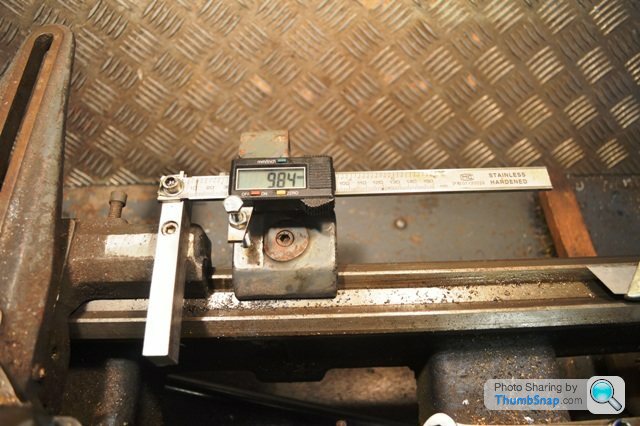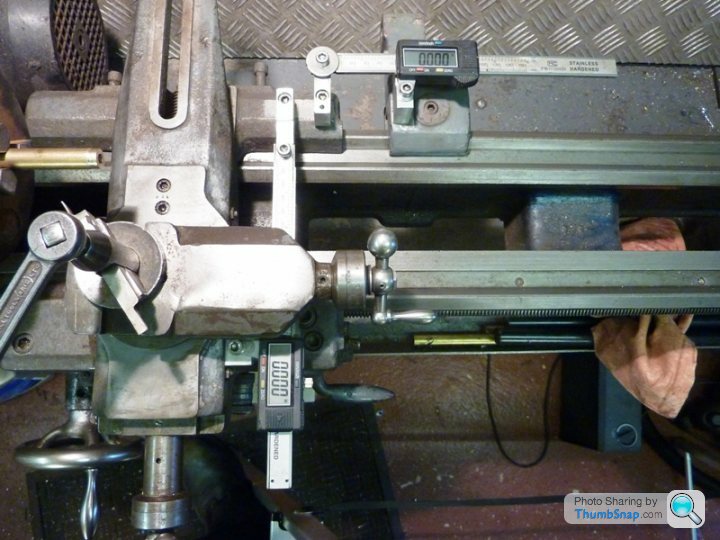DIY DRO (digital read out) on my lathe
Discussion
Stolen from one of the hobby forums... This is the modification I have just made to my lathe to give a digital read out facility on the traverse. Using a cheap digital calliper I now have the facility to easily and accurately measure without constantly stopping the lathe to measure. I am just about to do the same with the cross slide.
works a treat, and only someone with an old lathe will know just how useful this is to be able to switch from imperial to metric, and zero readings at the touch of a button!

works a treat, and only someone with an old lathe will know just how useful this is to be able to switch from imperial to metric, and zero readings at the touch of a button!

buzzer said:
someone with an old lathe will know just how useful this is to be able to switch from imperial to metric, and zero readings at the touch of a button!
What, and stop converting from thou to mm in my head? No fun 
Nice idea, like it. Mines due a strip down and refurb this year so I might think about doing that myself.
CrutyRammers said:
What, and stop converting from thou to mm in my head? No fun 
Nice idea, like it. Mines due a strip down and refurb this year so I might think about doing that myself.
In your head.... impressive 
Nice idea, like it. Mines due a strip down and refurb this year so I might think about doing that myself.

the most difficult bit was actually drilling the holes in the calliper... a HSS bit would not touch it, in the end I sharpened a masonry drill and used that.
buzzer said:
In your head.... impressive 
Not really 
 ...I tend to be making bushings and things which don't need half a thou' precision. So 40thou ~ 1mm. divide by 2 on the cross slide, 20 thou=1mm, 2 thou = 0.1mm...
...I tend to be making bushings and things which don't need half a thou' precision. So 40thou ~ 1mm. divide by 2 on the cross slide, 20 thou=1mm, 2 thou = 0.1mm...I've not yet had to make anything where I really care about anything below 1 thou.
[quote=CrutyRammers]
Not really ...I tend to be making bushings and things which don't need half a thou' precision. So 40thou ~ 1mm. divide by 2 on the cross slide, 20 thou=1mm, 2 thou = 0.1mm...
...I tend to be making bushings and things which don't need half a thou' precision. So 40thou ~ 1mm. divide by 2 on the cross slide, 20 thou=1mm, 2 thou = 0.1mm...
I've not yet had to make anything where I really care about anything below 1 thou.[/quote
I find inch fractions almost impossible to convert to Imperial or Metric in my head nowadays, I used to know them
off by heart when I was using them in my day job as did many of the people working in manufacturing. Happy Days.
Not really
 ...I tend to be making bushings and things which don't need half a thou' precision. So 40thou ~ 1mm. divide by 2 on the cross slide, 20 thou=1mm, 2 thou = 0.1mm...
...I tend to be making bushings and things which don't need half a thou' precision. So 40thou ~ 1mm. divide by 2 on the cross slide, 20 thou=1mm, 2 thou = 0.1mm...I've not yet had to make anything where I really care about anything below 1 thou.[/quote
I find inch fractions almost impossible to convert to Imperial or Metric in my head nowadays, I used to know them
off by heart when I was using them in my day job as did many of the people working in manufacturing. Happy Days.
Auntieroll]rutyRammers said:
Not really  ...I tend to be making bushings and things which don't need half a thou' precision. So 40thou ~ 1mm. divide by 2 on the cross slide, 20 thou=1mm, 2 thou = 0.1mm...
...I tend to be making bushings and things which don't need half a thou' precision. So 40thou ~ 1mm. divide by 2 on the cross slide, 20 thou=1mm, 2 thou = 0.1mm...
I've not yet had to make anything where I really care about anything below 1 thou.[/quote
I find inch fractions almost impossible to convert to Imperial or Metric in my head nowadays, I used to know them
off by heart when I was using them in my day job as did many of the people working in manufacturing. Happy Days.
Oh yeah I'm buggered when it gets into 64ths and stuff. Fortunately the conversions into decimals are engraved on the side of my micrometer. ...I tend to be making bushings and things which don't need half a thou' precision. So 40thou ~ 1mm. divide by 2 on the cross slide, 20 thou=1mm, 2 thou = 0.1mm...
...I tend to be making bushings and things which don't need half a thou' precision. So 40thou ~ 1mm. divide by 2 on the cross slide, 20 thou=1mm, 2 thou = 0.1mm...I've not yet had to make anything where I really care about anything below 1 thou.[/quote
I find inch fractions almost impossible to convert to Imperial or Metric in my head nowadays, I used to know them
off by heart when I was using them in my day job as did many of the people working in manufacturing. Happy Days.
Nice, job! This is on the long list of mods that I need to do - my lathe is properly ancient (A pre-war Grayson) and doesn't even have imperial scales on the controls so machining stuff accurately means a lot of stopping and starting.
I'd vaguely wondered how to drill a hole through the calipers for mounting, I was wondering if a cobalt bit would be up to the job but a masonry bit is a lot cheaper.
What is the clamp on the bed that you mounted the vernier on, is it some kind of stop that is part of the lathe anyway? Mine has nothing like that so I'd have to fabricate something.
The only snag with the cheap verniers is that they seem to guzzle batteries (pressing the power button doesn't really switch them off, just shuts down the display). I have a few of them, and seem to be forever fitting new batteries.
BTW, which forum do you post on? Would be useful to get other useful tips.
I'd vaguely wondered how to drill a hole through the calipers for mounting, I was wondering if a cobalt bit would be up to the job but a masonry bit is a lot cheaper.
What is the clamp on the bed that you mounted the vernier on, is it some kind of stop that is part of the lathe anyway? Mine has nothing like that so I'd have to fabricate something.
The only snag with the cheap verniers is that they seem to guzzle batteries (pressing the power button doesn't really switch them off, just shuts down the display). I have a few of them, and seem to be forever fitting new batteries.
BTW, which forum do you post on? Would be useful to get other useful tips.
Gassing Station | Home Mechanics | Top of Page | What's New | My Stuff




